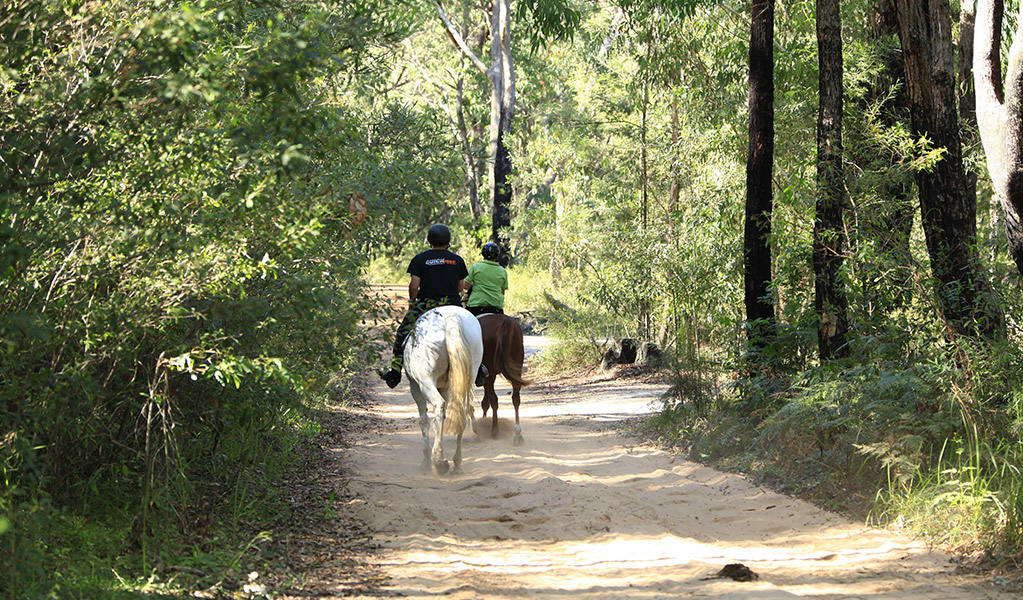Horse riding safety
Horse riding is a unique way to experience many of the national parks in NSW. Riding opportunities vary from relatively flat open areas to steeper terrain with more challenging trails through remote areas. Careful preparation for your horse ride will help ensure a safe and enjoyable time for horses and riders.
Read more about Horse riding safety
National parks such as Kosciuszko, Blue Mountains and Oxley Wild Rivers offer a range of riding opportunities. Choose your riding area carefully and consider hazards and situations your riding group may encounter. Consider the safety and presence of walkers, cyclists and in some locations, vehicles.
Follow this safety advice to help keep you and your riding group safe. More information can be found in the NPWS horse riding policy and code of practice for horse riding in parks.
Plan your ride
- Check the webpage of the national park you’re planning to visit to see if horse riding is permitted.
- Check whether your intended riding area is suitable for the experience level of horses and riders.
- Research your horse riding route and make sure that horses and riders are able to complete the distance and negotiate the terrain type.
- Ensure your horse is familiar with and accepting of the type of hazards they may encounter in national parks. This may include more challenging terrain, tracks and water crossings, wildlife, wild horse encounters as well cyclists, motorcyclists and campers.
- Check that all saddlery and horse riding equipment is in good working order and fits the horse properly.
- Check availability of parking places for your floats, trucks and other horse-related equipment like portable yards.
- Make sure you and your horse will have access to clean, fresh water along the route and that you manage and treat heat stress for your horse if exercising in hot environments.
- Check the weather forecast and park alerts before setting out.
Consider your experience
If you are a first-time rider, or you and your horse are less experienced in remote and challenging locations, consider joining a commercial operator.
Tell somebody
Give your route details to family and friends who are not riding with you. Tell them when you expect to return and let them know when you have returned. For longer trips, consider filling out a trip intention form.
Ride safely
- Never ride alone.
- Place the most experienced riders at the front and tail of a group.
- Ensure that less experienced riders are mounted on experienced and trusted horses to improve safety for horses and riders.
- Ride at the pace of the least experienced rider.
- Ride within your own abilities and your horse’s capabilities.
- You may encounter people who are unfamiliar with horses and who may be intimidated by them. Ride in single file at a walk past other park visitors.
- Be aware that bikes may approach rapidly and unannounced and can frighten less experienced horses and riders.
- If you are leading a horse riding group, ensure that all riders are suitably mounted.
Stay on marked tracks
- Only ride on tracks marked for horse riding.
- Riders must give way to walkers in a shared zone.
- If riding on shared roads with vehicles, ride on the left-hand side with the flow of traffic.
- Riders slow down and move to the right in single file when over taking others.
- Riders going downhill give way to other trail users coming up.
What to wear
- We strongly recommend that all riders wear an Australian Standards approved riding helmet. Riders under 18 years of age must wear a helmet while riding in a park.
- Wear suitable riding boots with a low heel.
- Wear or take suitable clothing for all weather conditions.
- Wear sun protection (hat and long sleeves). At higher altitudes the UV can be quite high even when temperatures are moderate.
What to bring
- Drinking water and snacks for shorter rides.
- First aid kit for horses and riders.
- Your mobile phone or a satellite phone. Download the Emergency Plus app.
- In remote areas, carry a Personal Locator Beacon (PLB) because you might not have mobile phone reception.
- Emergency gear such as spare rope, halter, bridle, girth, stirrup leather as well as a torch or light.
- Wet weather gear. Be prepared for sudden weather changes especially at higher altitudes.
- On longer trips take a topographic map, compass, food for you and weed-free feed for your horses. For example, pellets, extruded feeds and some chaffs. Many national parks do not allow hay. Check the webpage of the national park you'll be visiting.
- Ensure each rider carries essentials such as water, food, spare clothing and emergency equipment in a backpack (not saddlebags) so it isn’t lost if a rider is separated from their horse.

